What is the “FAFSA fiasco,” and how can you overcome it to keep your enrollment up this fall?
Keep reading for out-of-the-box tips from Interact’s new VP of Account Services, Lisa Kasper, who has 30+ years of experience in enrollment management at four- and two-year colleges!
“It’s a weird time in higher education,” says Kasper. “The biggest issue right now is the ‘FAFSA debacle,’ or the ‘FAFSA fiasco.’ Many schools were forced to delay their commitment dates and the timing of their admitted student events as a result.
“The FAFSA fiasco profoundly affects community college students because so many depend on financial aid to attend school.”
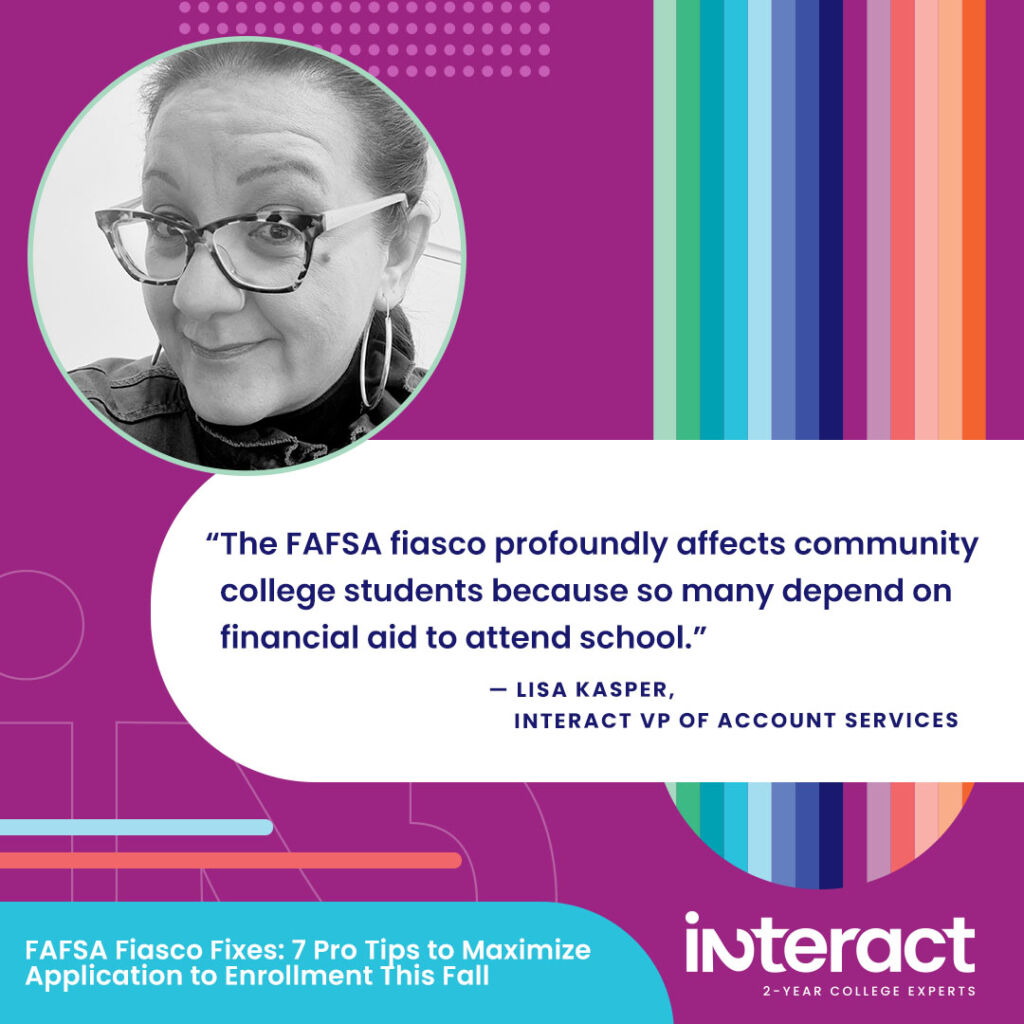
What Is the ‘FAFSA Fiasco,’ and Why Did It Happen?
A little history: In 2020, Congress passed the FAFSA Simplification Act to improve how federal student aid is awarded, starting with the 2024-2025 academic year. It was a good idea: The Free Application for Federal Student Aid has long been known to be complicated, confusing, and cumbersome to complete. It definitely needed fixing!
However, the new FAFSA was not ready for release this year and was enacted too soon. Even in 2020, top education officials were warned about significant hurdles requiring more time and “sustained attention,” according to the New York Times. The FAFSA launched late at the end of December and was full of errors and glitches.
“About 30% of submitted FAFSAs — or roughly 2.1 million forms — are affected by data or processing errors, the Education Department said on April 9,” reads the Nerd Wallet article, FAFSA Delays and Errors: Here’s What Students and Families Can Do.
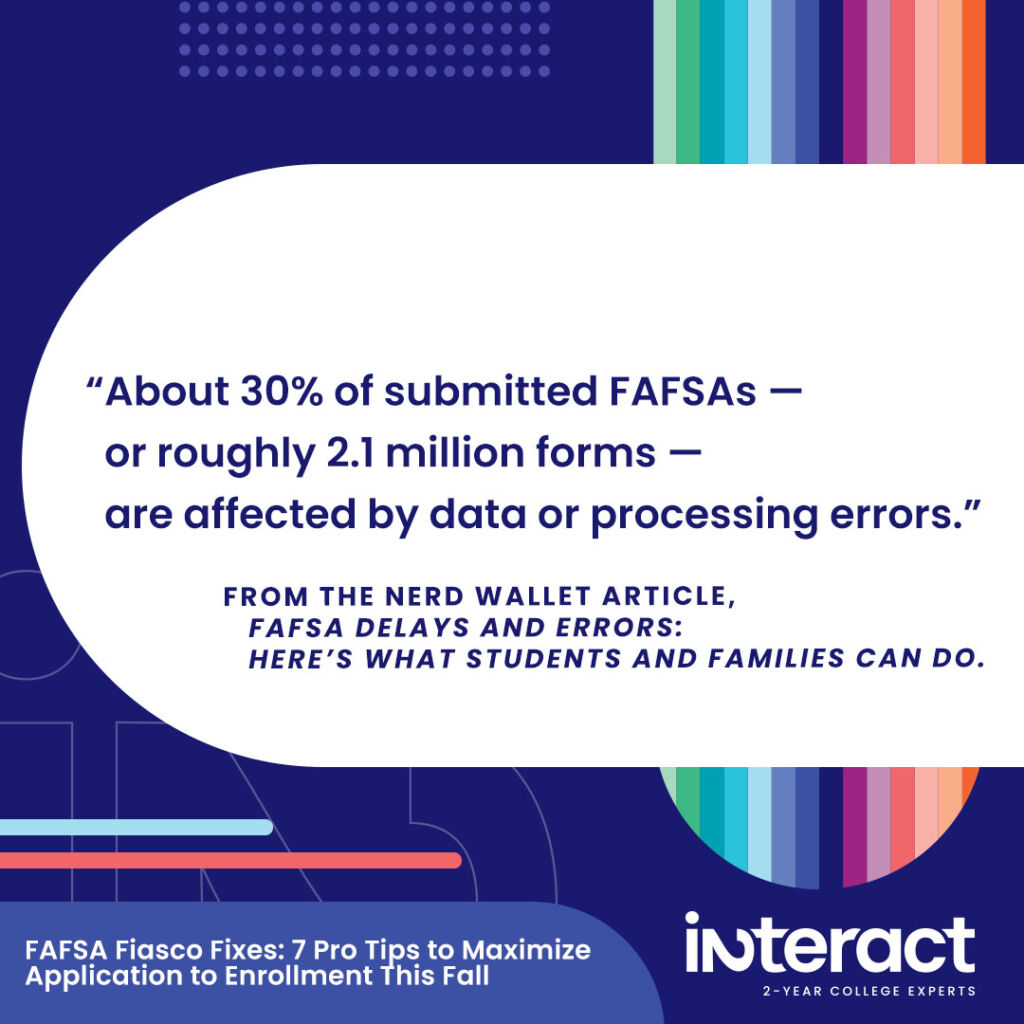
This year’s rough rollout delayed financial aid packages, disrupting student decision timelines nationwide. Issues with the application also created a significant decline in completed FAFSAs compared to last year, according to the National College Attainment Network.
“Many students are holding off on enrolling at institutions because they need to know exactly how much they will owe in order to enroll,” says Angel Perez, CEO of the National Association for College Admission Counseling, in a recent NPR interview, The FAFSA Debacle is Throwing a Wrench in Students’ College Plans. “The students that will be most impacted are the students for whom FAFSA was created — those students who need the most resources in order to go to college.”

Fixes for the FAFSA Fiasco
Tip #1: Increase Your Outreach
“Many of the schools I’ve worked with are intensifying their outreach,” says Kasper. “The bottom line is good communication. Students need answers, and if they can’t get definitive information immediately, they need someone to guide them through the steps at the very least.”
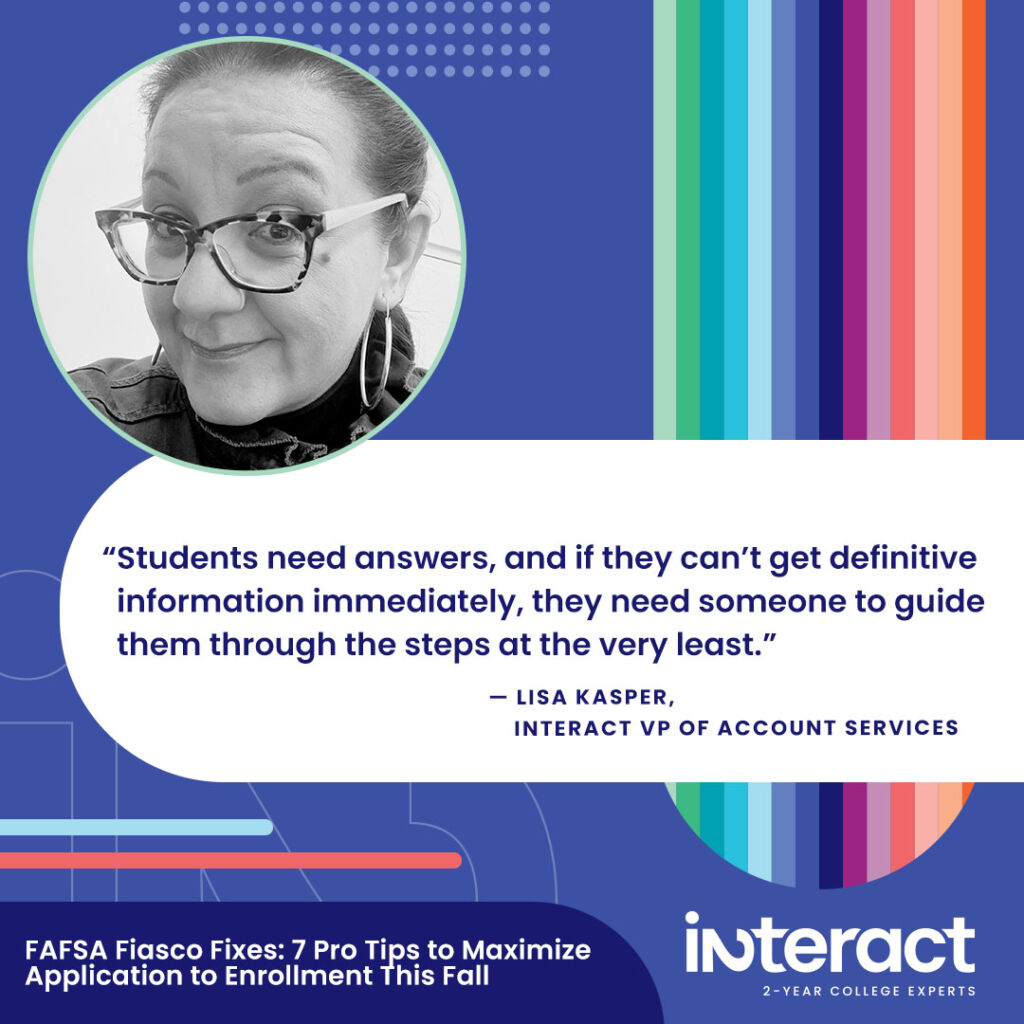
For example, she says the City University of New York schools have sites open on weekends and evenings offering increased info and help. That personalized support is crucial right now. Prospects want to sit down and talk with specialists about their particular problems. After all, financial aid is based on multiple variables, so getting personalized support for their specific situation is key.
“Students crave a person — an actual person — to share their unique situation with and get personalized advisement, not a one-size-fits-all solution from the website,” says Kasper.
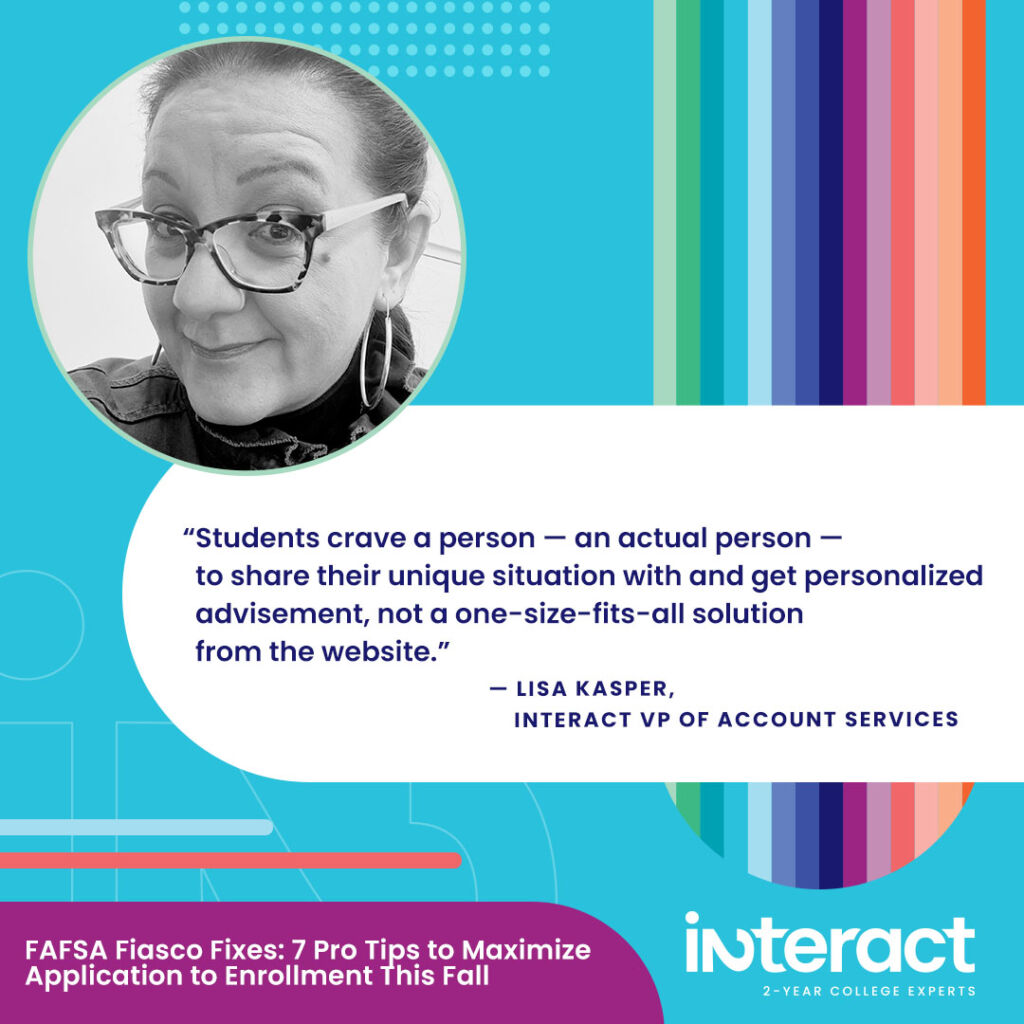
We get it — for smaller schools, having late-night advising hours might not be in the budget. So, keep reading for plenty of other strategies you can leverage to enhance outreach opportunities. For the top budget-friendly solution, Kasper says to try capitalizing on your texting platform:
Tip #2: Triumph over the FAFSA Fiasco with Well-Timed Texts
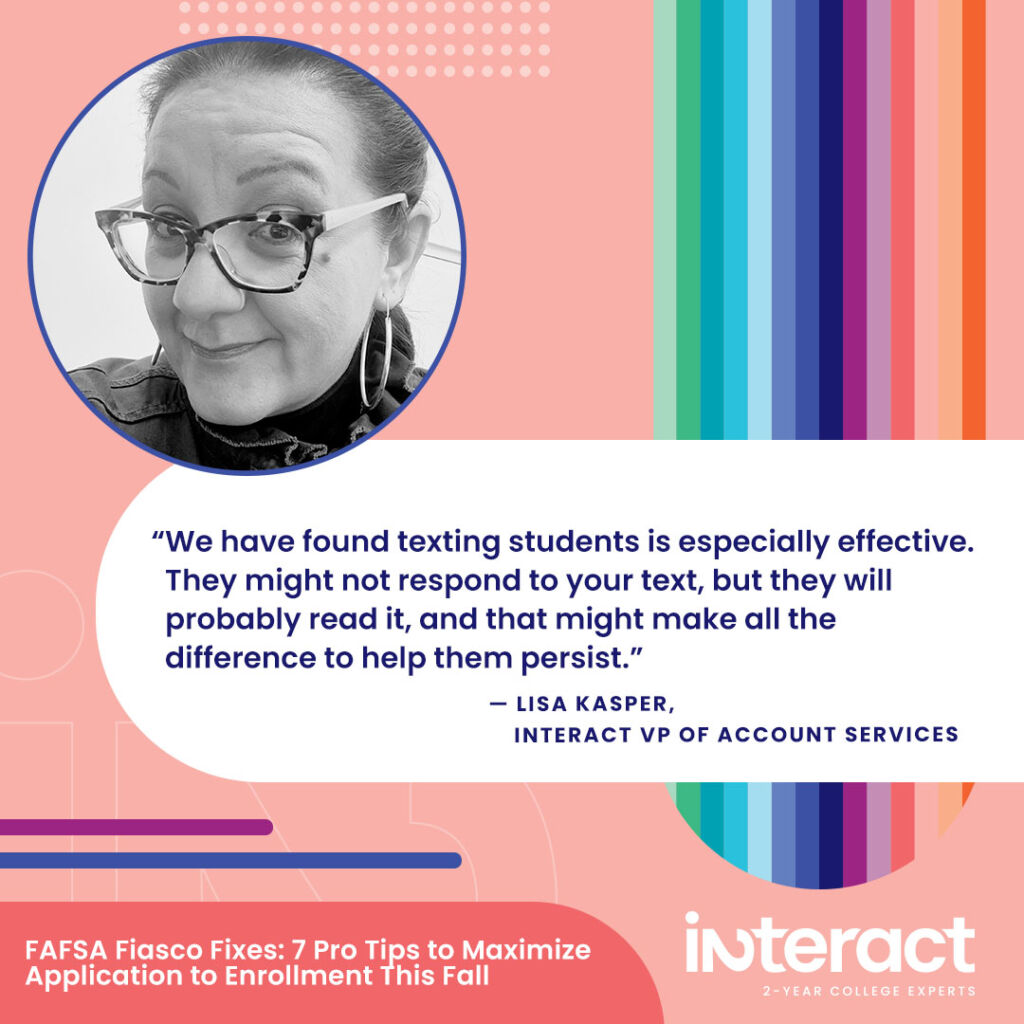
“We have found texting students is especially effective,” says Kasper. “They might not respond to your text, but they will probably read it, and that might make all the difference to help them persist.”
Let students know they are only a text or call away from support. Make sure they know that you are here for them every step of the way. Send them reminders of deadlines, your help hours, and how they can reach out. A well-timed reminder with friendly support can be the difference between making it to the first day of class or stopping out.
“Never undervalue a simple text,” says Kasper. “It’s an easy, cost-effective way to meet students where they are.”
Tip #3: Faculty Phone Calls Go a Long Way to Defeat the FAFSA Fiasco
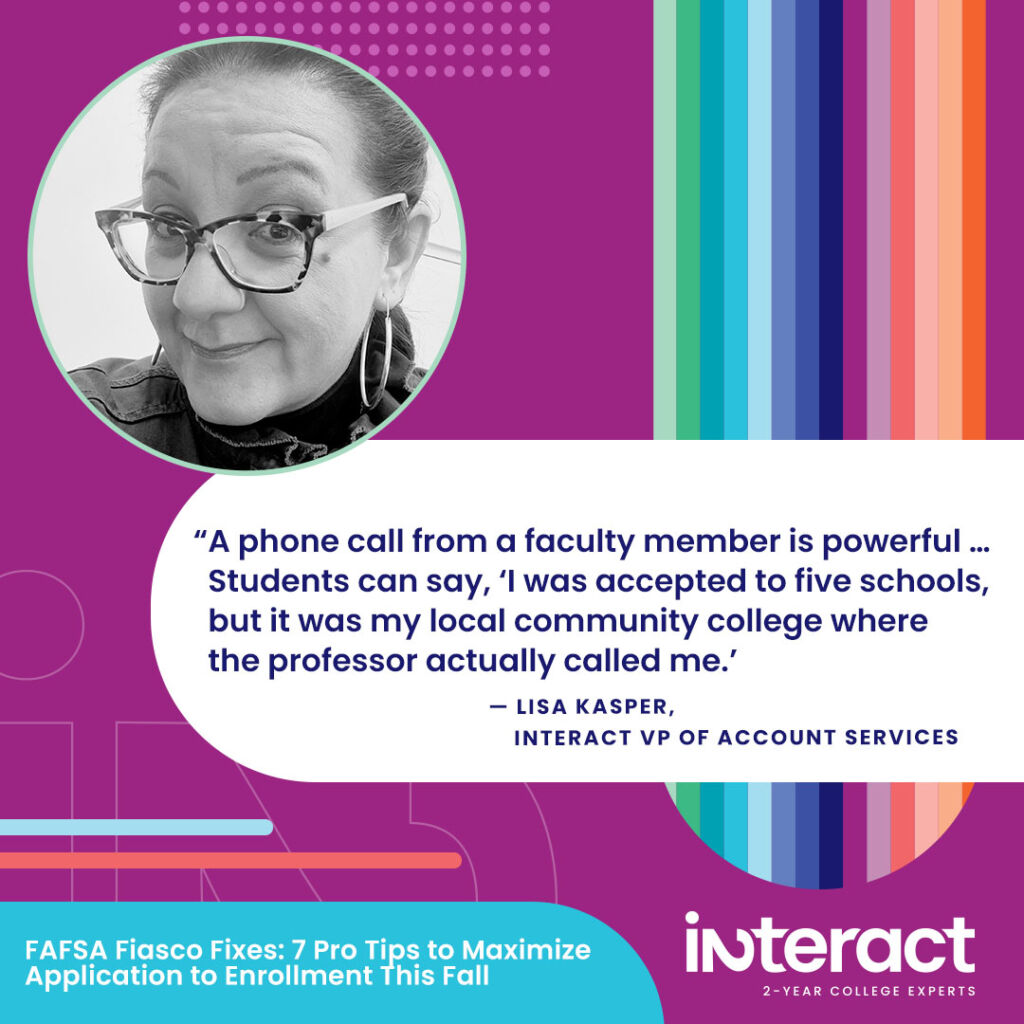
“A phone call from a faculty member is powerful and can inspire a student,” says Kasper. “Students can say, ‘I was accepted to five schools, but it was my local community college where the professor actually called me.’”
In fact, promoting faculty phone calls to new students was one of our top tips for freezing summer melt and bolstering enrollment. In our Media Prefs survey, students say their main supporters are their instructors. So, having your faculty members give new students a ring is an honor. And, it’s a simple way to ensure applicants come to the first day of classes. [Read more: How to Increase Student Enrollment, with Secrets to Beat Summer Melt]
Tip #4: Students Helping Students Helps Enrollment
Another budget-friendly tip that can also bolster your workforce is enlisting more work-study students to help out.
“I’ve led a couple of different institutions where we had intense training for work-study students to help with outreach,” says Kasper. “In many cases, we were able to hire them long-term as college assistants.”
Student workers can be an untapped resource for part-time help and, eventually, even full-time employees. Kasper says to make no mistake: It is hard work to train work-study students. But the results are well worth it, and a win-win for the college and students.
“Very often, students will respond so much more transparently and honestly to other students,” says our VP. “I’ve seen schools overcome a resource or budget gap by making the most of their work-study students.”
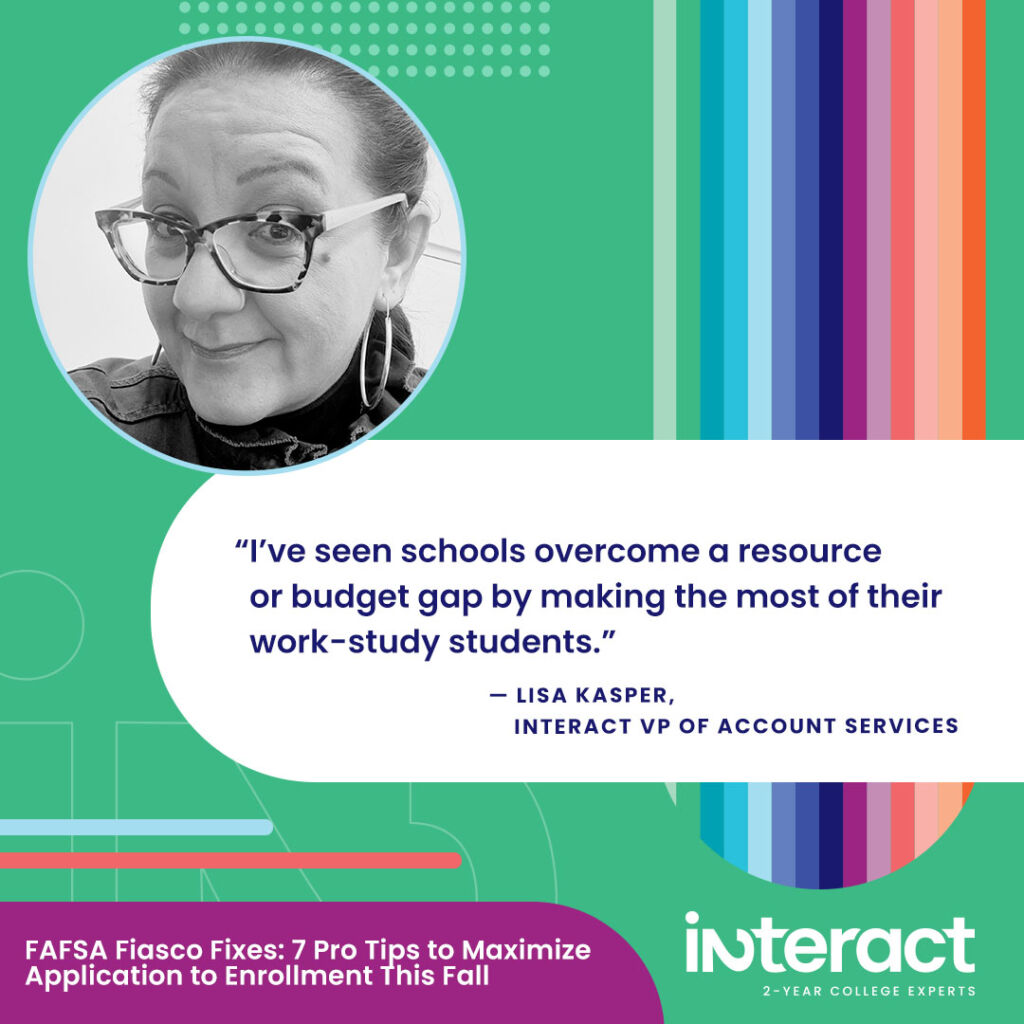
Tip #5: Mantras to Keep Calm During the August Enrollment Rush
Whether or not the FAFSA fiasco translates into an enrollment dip remains to be seen. But, according to Kasper, “We will likely see enrollment delays.”
Students who are college-focused will overcome the hurdles to enroll. But, “The ones on the fence might get there at the eleventh hour — I think we can expect more of those mid-to-late August enrollments.”
August will probably be an especially crunchy crunch time for fall enrollment. So, Kasper says to be sure to lead by example.
“Keep telling your staff that there is a light at the end of the tunnel — be a force for positivity,” says our VP. “At the end of the day, we’re helping students change the course of their lives — never lose sight of that.”
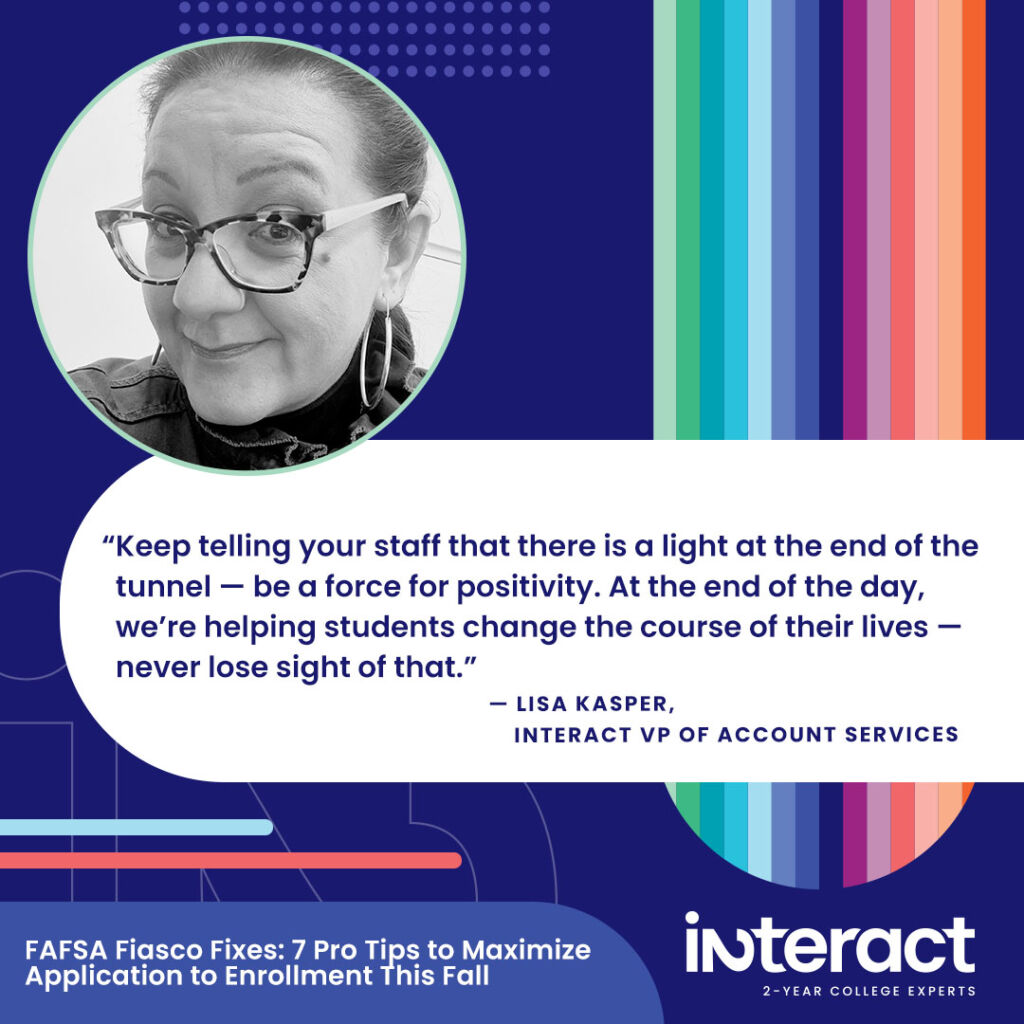
Tip #6: Gen Z Messaging That Hits the Mark
To overcome the FAFSA fiasco, it’s crucial to ensure your communications are on point, especially for the new traditional students.
“It’s a different generation we’re serving now, and they have very different needs,” says Kasper. From Interact’s research, we know Gen Z students are self-driven, community-oriented, and tend to be a bit more skeptical regarding school.
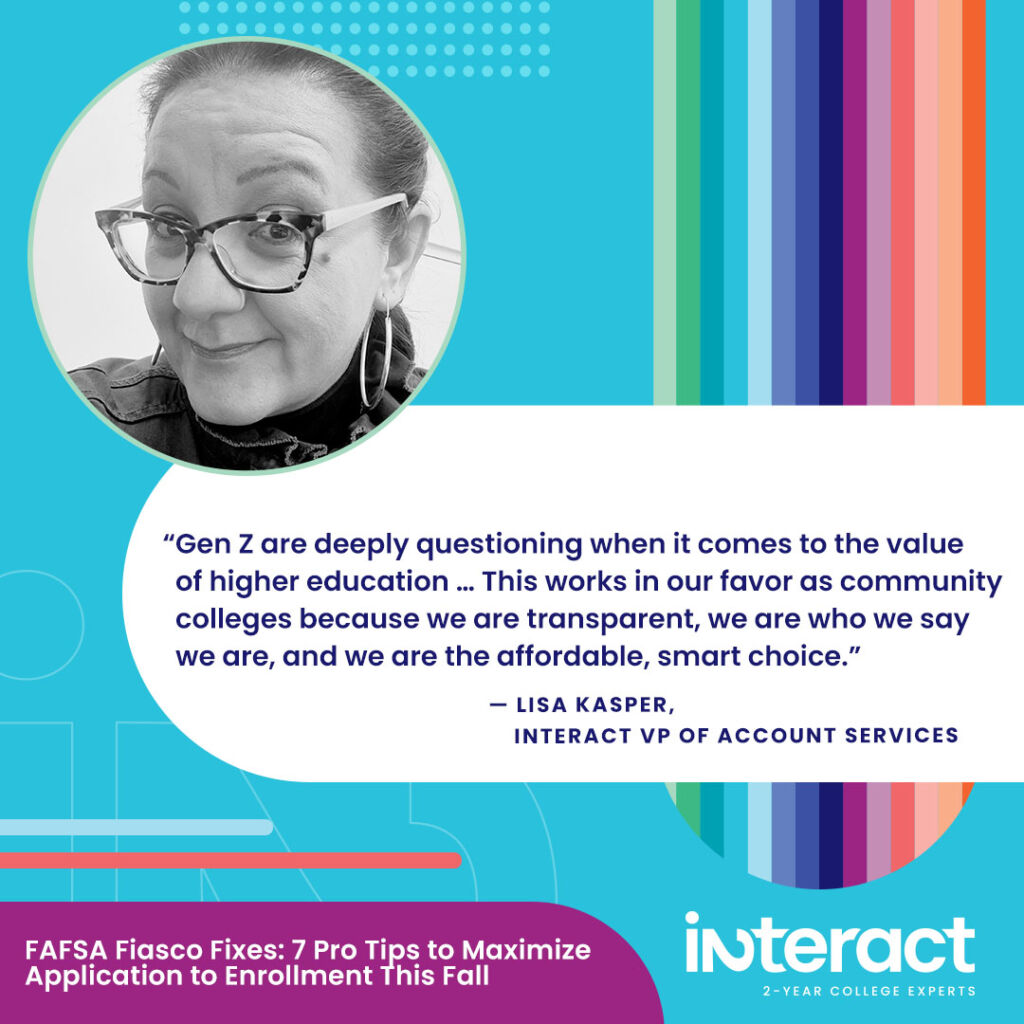
“Gen Z are deeply questioning when it comes to the value of higher education and want to crunch their own numbers,” says Kasper. “This works in our favor as community colleges because we are transparent, we are who we say we are, and we are the affordable, smart choice.”
Does your messaging remind students of why education is important — in addition to what they need to do? When the times get tough with the FAFSA fiasco and beyond? Try adding a little aspirational messaging can help students persevere from application to matriculation.
In the wake of the pandemic and our increasingly tech-driven society, Gen Z prospects also value feeling connected.
“Keep Gen Z’s craving for connection at the forefront of your messaging,” advises Kasper. “Instead of transactional, directive language, keep your communications encouraging, inspiring, and supportive. Students want to feel like they are important, which needs to infuse all of our messaging across platforms.”
Speaking of messaging, you don’t have to figure it all out on your own.
Tip #7: You Don’t Have to Fend Off the FAFSA Fiasco Alone!
This might be an especially stressful enrollment period. But the good news is, there is support.
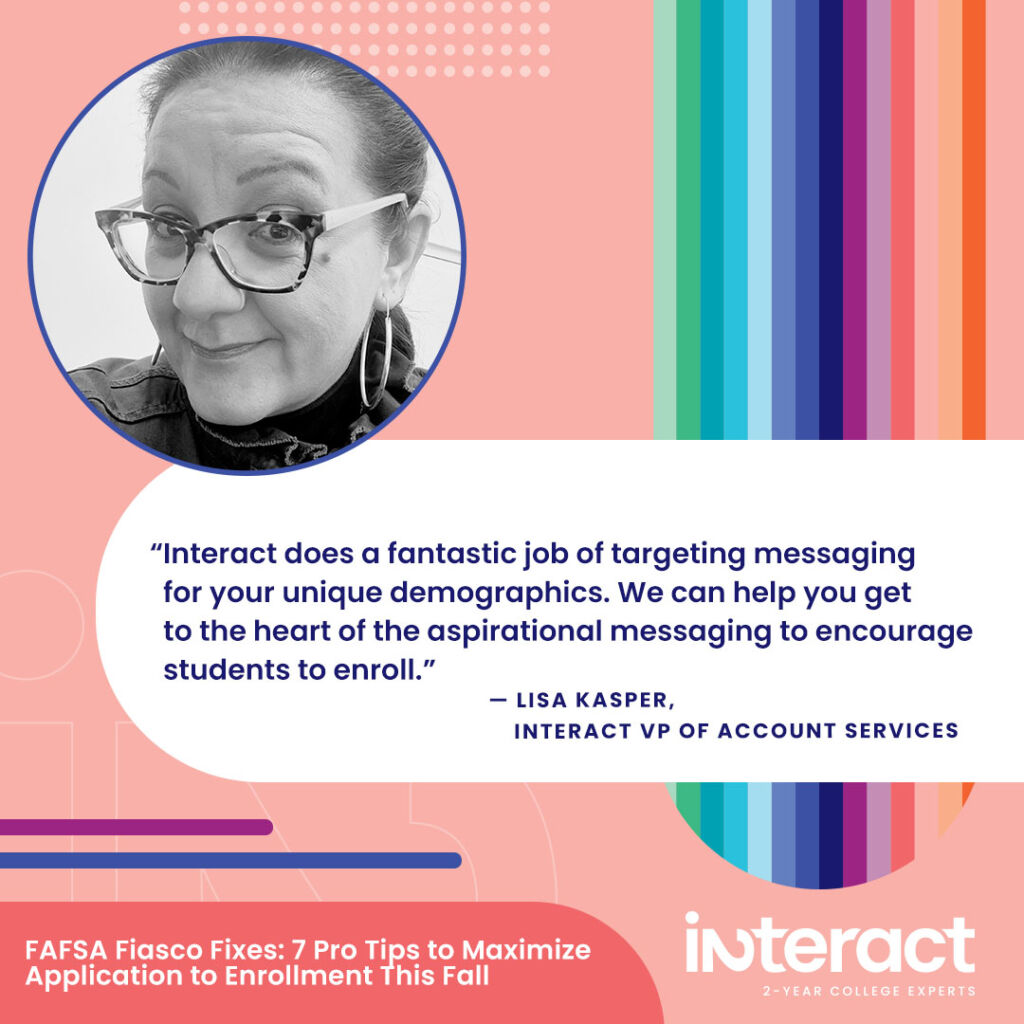
“Interact does a fantastic job of targeting messaging for your unique demographics,” says Kasper. “We can help you get to the heart of the aspirational messaging to encourage students to enroll.”
Remember to take into account the following for effective communications:
- Why is your college the best place for your particular students?
- How can you support and encourage incoming students as people, not just prospects?
- How can you differentiate what is unique about your college that students won’t find anywhere else?
“Anyone can write communications that say, ‘Here’s what you do next,’” says Kasper. “But we can help you uncover the why — the aspirational, motivational messaging that will resonate most with your target audiences and set your college apart from your competitors.”
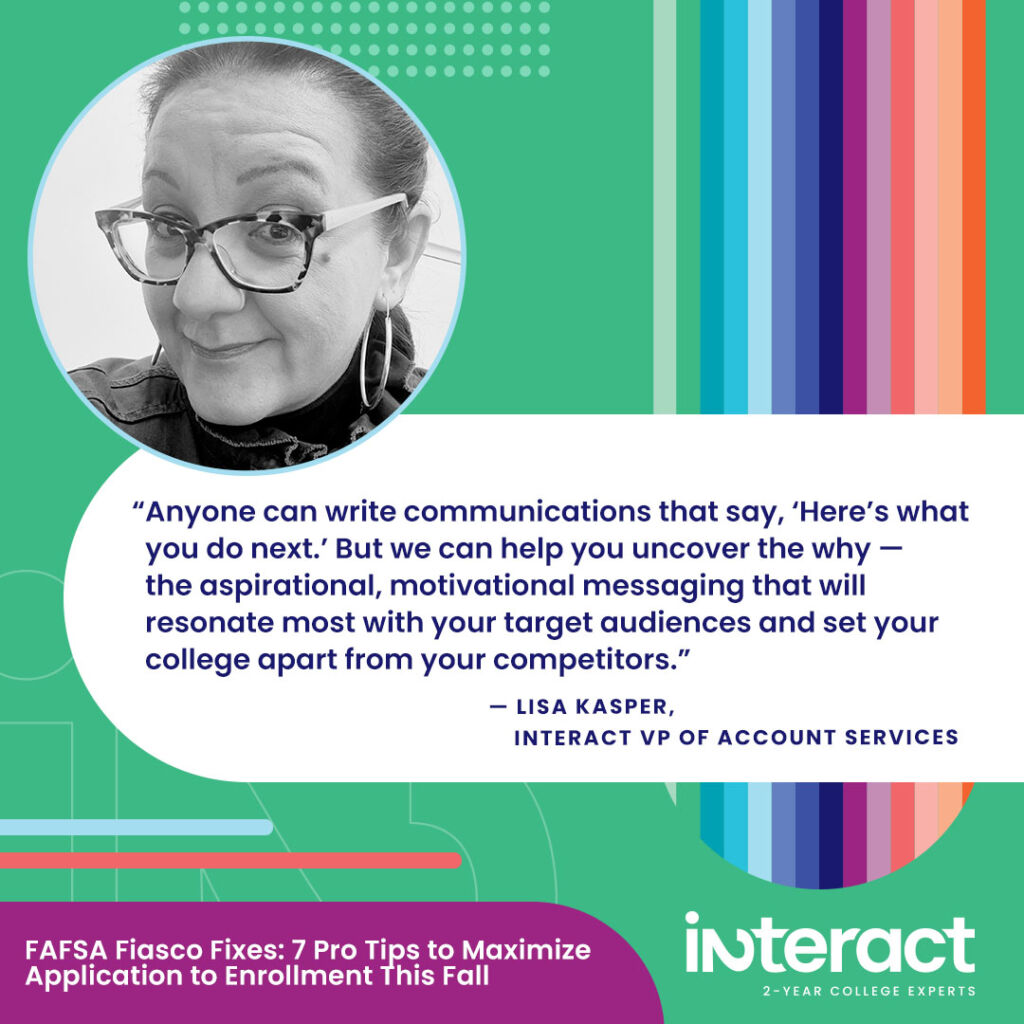
Don’t let the FAFSA fiasco stall out your students! Reach out for a complimentary consult and find out how we can help you keep your enrollment strong this fall and all year long.



